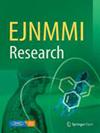Short post-injection seizure duration is associated with reduced power of ictal brain perfusion SPECT to lateralize the seizure onset zone
IF 3.1
3区 医学
Q1 RADIOLOGY, NUCLEAR MEDICINE & MEDICAL IMAGING
引用次数: 0
Abstract
The aim of this study was to assess the impact of the post-injection electrical seizure duration on the identification of the seizure onset zone (SOZ) in ictal brain perfusion SPECT in presurgical evaluation of drug-resistant epilepsy. 176 ictal SPECT performed with 99mTc-HMPAO (n = 140) or -ECD (n = 36) were included retrospectively. Visual interpretation of the SPECT images (together with individual MRI and statistical hyperperfusion maps) with respect to lateralization (right, left, none) and localization (temporal, frontal, parietal, occipital) of the SOZ was performed by 3 independent readers. Between-readers agreement was characterized by Fleiss’ κ. An ictal SPECT was considered "lateralizing" if all readers agreed on right or left hemisphere. It was considered "localizing" if it was lateralizing and all readers agreed on the same lobe within the same hemisphere. The impact of injection latency and post-injection seizure duration on the proportion of lateralizing/localizing SPECT was tested by ANOVA with dichotomized (by the median) injection latency and post-injection seizure duration as between-subjects factors. Median [interquartile range] (full range) of injection latency and post-injection seizure duration were 30 [24, 40] (3–120) s and 50 [27, 70] (-20–660) s, respectively. Fleiss’ κ for lateralization of the SOZ was largest for the combination of early (< 30 s) injection and long (> 50 s) post-injection seizure duration (κ = 0.894, all other combinations κ = 0.659–0.734). Regarding Fleiss’ κ for localization of the SOZ in the 141 (80.1%) lateralizing SPECT, it was largest for early injection and short post-injection seizure duration (κ = 0.575, all other combinations κ = 0.329–0.368). The proportion of lateralizing SPECT was lower with short compared to long post-injection seizure duration (estimated marginal means 74.3% versus 86.3%, p = 0.047). The effect was mainly driven by cases with very short post-injection seizure duration ≤ 10 s (53.8% lateralizing). Injection latency in the considered range had no significant impact on the proportion of lateralizing SPECT (p = 0.390). The proportion of localizing SPECT among the lateralizing cases did not depend on injection latency or post-injection seizure duration (p ≥ 0.603). Short post-injection seizure duration is associated with a lower proportion of lateralizing cases in ictal brain perfusion SPECT.注射后癫痫发作持续时间短与发作期脑灌注 SPECT 侧定癫痫发作区的能力下降有关
本研究旨在评估在耐药性癫痫的手术前评估中,注射后电发作持续时间对发作开始区(SOZ)的识别的影响。回顾性纳入了176例使用99m锝-HMPAO(n = 140)或-ECD(n = 36)进行的发作期SPECT。SPECT图像(连同单独的核磁共振成像和统计高灌注图)与SOZ的侧位(右侧、左侧、无)和定位(颞叶、额叶、顶叶、枕叶)有关的视觉判读由3位独立读者完成。阅读者之间的一致性用弗莱斯κ表示。如果所有读者对右半球或左半球的看法一致,则发作期 SPECT 被认为是 "偏侧 "的。如果SPECT具有侧向性,且所有读者一致认为是同一半球的同一脑叶,则该SPECT被认为具有 "定位性"。注射潜伏期和注射后发作持续时间对侧化/定位SPECT比例的影响通过方差分析进行检验,注射潜伏期和注射后发作持续时间作为受试者间因素进行二分(按中位数)。注射潜伏期和注射后癫痫发作持续时间的中位数[四分位间范围](全范围)分别为30 [24, 40] (3-120)秒和50 [27, 70] (-20-660) 秒。早期(50 秒)注射后发作持续时间组合中,SOZ 侧化的 Fleiss' κ 最大(κ = 0.894,所有其他组合 κ = 0.659-0.734)。关于 141 例(80.1%)侧向 SPECT 中 SOZ 定位的 Fleiss'κ 值,早期注射和注射后发作持续时间短时的κ值最大(κ = 0.575,所有其他组合 κ = 0.329-0.368)。注射后癫痫发作持续时间短的病例侧化 SPECT 的比例低于持续时间长的病例(估计边际平均值为 74.3% 对 86.3%,p = 0.047)。这种影响主要来自于注射后发作持续时间很短(≤ 10 秒)的病例(53.8% 侧向化)。在考虑范围内的注射潜伏期对侧向化 SPECT 的比例没有显著影响(p = 0.390)。在侧向化病例中,定位 SPECT 的比例与注射潜伏期或注射后癫痫发作持续时间无关(p ≥ 0.603)。注射后发作持续时间短与发作期脑灌注SPECT中侧位化病例比例较低有关。
本文章由计算机程序翻译,如有差异,请以英文原文为准。
求助全文
约1分钟内获得全文
求助全文
来源期刊

EJNMMI Research
RADIOLOGY, NUCLEAR MEDICINE & MEDICAL IMAGING&nb-
CiteScore
5.90
自引率
3.10%
发文量
72
审稿时长
13 weeks
期刊介绍:
EJNMMI Research publishes new basic, translational and clinical research in the field of nuclear medicine and molecular imaging. Regular features include original research articles, rapid communication of preliminary data on innovative research, interesting case reports, editorials, and letters to the editor. Educational articles on basic sciences, fundamental aspects and controversy related to pre-clinical and clinical research or ethical aspects of research are also welcome. Timely reviews provide updates on current applications, issues in imaging research and translational aspects of nuclear medicine and molecular imaging technologies.
The main emphasis is placed on the development of targeted imaging with radiopharmaceuticals within the broader context of molecular probes to enhance understanding and characterisation of the complex biological processes underlying disease and to develop, test and guide new treatment modalities, including radionuclide therapy.
 求助内容:
求助内容: 应助结果提醒方式:
应助结果提醒方式:


